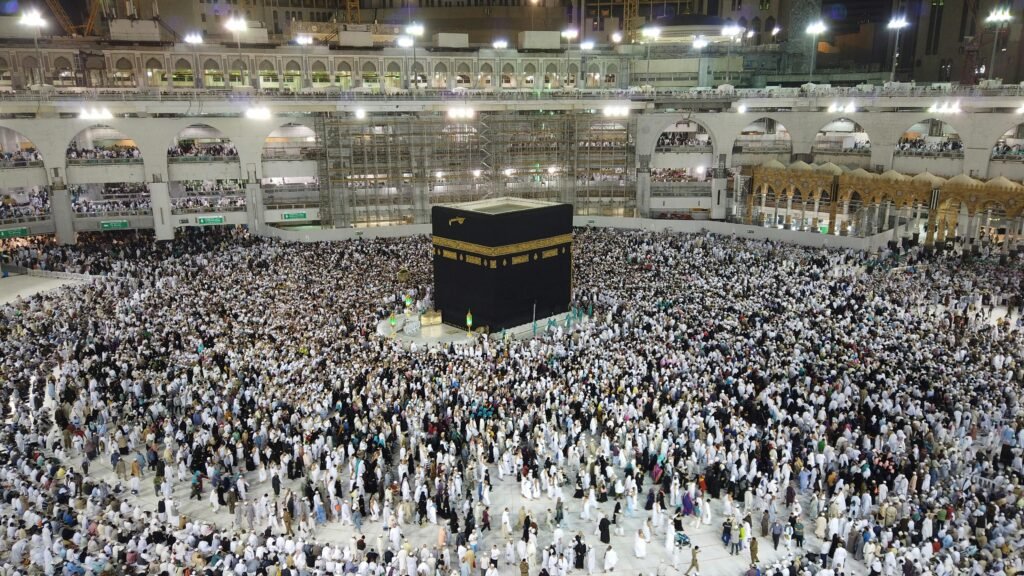Umrah is an essential act of worship; it means visiting or pilgrimage to a place. It is also known as “Tawaf Al-Qudoom.” In Islamic terminology, Umrah refers to performing specific rituals at Masjid Al-Haram at any time of the year to seek Allah’s pleasure by wearing Ihram from the Miqat and completing prescribed actions.
To learn more about Umrah in detail, visit the article below
https://travelinmakkah.com/umrah-introduction/
Narrated by Abu Hurairah (5), the Messenger of Allah said, “The sins (minor) committed between one Umrah and the next are expiated (atoned for).” Bukhari-1773, Nasai-2622.
Narrated by Abdullah ibn Abbas (5), the Messenger (2) said, “Performing Umrah in the month of Ramadan is equivalent to performing Hajj with me or equivalent to performing an obligatory Hajj.” Bukhari-1863, Muslim-2929.
Narrated by Abu Hurairah (5), “The Messenger (3) said, ‘The jihad of the elderly, the weak, children, and women is performing Hajj and Umrah.'” Nasai-2626.
Narrated by Ibn Umar (?), the Messenger (S) said, “Those who fight in the way of Allah and those who perform Hajj and Umrah are Allah’s guests.” Ibn Majah-2893.
From entering Masjid Al-Haram to performing Tawaf, Sa’i, and becoming halal, Umrah can be completed in 2-3 hours.
Sequence of Umrah
Wearing Ihram from Miqat.
Performing Tawaf of the Kaaba.
Performing Sa’i between Safa and Marwah.
Cutting or shaving the hair.
Fard, Wajib, and Sunnah of Umrah
Fard
Wearing Ihram.
Performing Tawaf.
Performing Sa’i.
Wajib
Wearing Ihram from Miqat.
Cutting or shaving the hair.
Performing two rak’ahs of prayer after Tawaf.
Sunnah
Kissing the Black Stone (Hajr-e-Aswad).
For men, performing Idtiba and Ramal.
Touching the Yemeni corner.
Performing two rak’ahs of prayer after Tawaf.
If any Fard is missed or the sequence is broken, the Umrah becomes invalid, and one must wear the Ihram again and perform Umrah afresh. If any Wajib is missed or broken, one must either sacrifice an animal (dam) after completing Umrah or wear Ihram again and perform Umrah afresh. It is not an issue if a Sunnah is missed due to a valid reason or unintentionally. However, intentionally skipping a Sunnah is undesirable.
Ihram
The literal meaning of Ihram is to make something forbidden, restricted, or unauthorized. The act of wearing Ihram marks the beginning of Hajj or Umrah rituals.
During Hajj and Umrah, wearing the Ihram cloth is mandatory. Specific actions become prohibited in the state of Ihram. All men wear the same type of garment in Ihram, eliminating differences based on wealth, race, or color. Ihram removes distinctions of nationality, class, and culture among people.
There are different types of Ihram garments. For more details about these garments, visit the article below:
https://travelinmakkah.com/ihram-clothing-for-hajj-or-umrah/
To learn more about Ihram in detail, visit the article below:
https://travelinmakkah.com/ihram/
Tawaf
The general meaning of Tawaf is to circumambulate or make circuits around the Kaaba. Seven circuits around the Kaaba are performed in the prescribed manner of Shariah, which is called Tawaf. The reward for performing Tawaf is immense.
The Kaaba was the first house built on earth to worship Allah. Allah has not commanded Tawaf of any other structure on earth. Allah accepts prayers offered during Tawaf.
To learn more about Tawaf in detail, visit the article below
https://travelinmakkah.com/tawaf-for-umrah/
Sa’i
Sa’i means walking or running between the hills of Safa and Marwah. Safa Hill is located southeast of the Kaaba, and Marwah Hill is located northeast of the Kaaba. The area between the two hills, where Sa’i is performed, is called Mas’aa. Domes are built over the two hills.
Sa’i can also be performed on the basement, ground floor, first floor, second floor, or roof if necessary. However, Sa’i must not be conducted outside the Mas’aa area of Safa and Marwah.
To learn more about Sa’i in detail, visit the article below
https://travelinmakkah.com/sai/
Halq/Taqsir (Haircut/Shaving)
After completing Sa’i, one may trim (Taqsir) the hair equally from all parts of the head. However, shaving (Halq) the entire head is more virtuous. Bald individuals must shave their bare heads with a razor or blade.
Allah says, “Certainly, you shall enter Masjid Al-Haram in security, if Allah wills, with your heads shaved or hair cut short.” Surah Al-Fath: 48:27.
To learn more about Halq/Taqsir in detail, visit the article below



